4960 is a 2-8-2 'Mikado' steam locomotive. It has hauled numerous excursions, a museum train, and now hauls tourists and railfans on the Grand Canyon Railway in Arizona. Converted to run on waste vegetable oil, the locomotive has been called "the Greenest train in America".
History
CB&Q 4960 was built by the Baldwin Locomotive Works of
Pennsylvania in 1923. 4960 was ordered and used by the Chicago,
Burlington, and Quincy Railroad until the end of their steam operations
in the late 1950s, and was used for excursion service and specials until
sold off to live out its life on tourist railroads.
In 1961, the locomotive recieved new flues, tires, tubes, and more in a major overhaul to continue hauling excursions. 4960 was also painted gold for CB&Q's 50th anniversary of service.
In 1962, 4960 doubleheaded with CB&Q 5632 on the Illinia Railroad Club special to Savanna via Denrock, and returned via the mainline with 5632 running light-engine.
In 1966, the CB&Q retired 4960 and sold it to the Circus World Museum (CMW) to haul their circus museum train throughout Wisconsin. 4960 once had an auxiliary tender, although it is presumably scrapped.
4960 was later leased from the CMW to the Bristol & Northwestern Railroad in Virginia. The railroad was unsuccessful and closed in 1984. The next year, 4960 was sold to the Grand Canyon Railway. In 1989, restoration began.
Today, CB&Q 4960 runs on the Grand Canyon Railway, which runs from Williams, Arizona, to the South Rim of the Grand Canyon. It received a new pilot, a center-mounted headlight, a smokebox-mounted bell, and an all-new larger tender. As of 2011, the locomotive runs once a month and has been converted to burn eco-friendly waste vegetable oil.
Interesting information from: http://www.thetrain.com/the-train/history-of-the-train/
Since 1901 the Grand Canyon Railway has enchanted millions of people from all over the world. From its yesteryears of transporting ore to our present-day journeys to the canyon with the help of authentic characters who bring the Old West to life, the story of our railway is almost as dramatic as the spectacular surroundings.
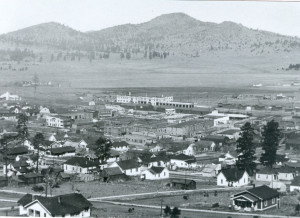
The train—whose fate seemed sealed when it was shut down back in 1968 due to the popularity of automobiles—is now responsible for keeping approximately 50,000 cars outside of a national treasure. By traveling aboard Grand Canyon Railway you are not only part of history in the making, you are also doing your part to help preserve the pristine, incredible beauty of Grand Canyon National Park.
Back in the late 1800s, the Grand Canyon was a far-off distant land. Only the most adventurous of explorers could rough the elements to see it at its remote location in northern Arizona, which was still a territory at the time. But Americans were on the move and going west. American ingenuity was hard at work in the form of the railroads, being built and tying the nation together.
Initially, the main line west was built from Chicago to Los Angeles and it passed through Williams, Arizona. The Railroad was originally built to transport ore in the Wild West from the Anita mines, 45 miles north of Williams, in the late 1800s. Buckey O’Neill, sheriff of Yavapi County, mayor of Prescott, prospector, promoter and later one of Teddy Roosevelt’s Rough Riders, realized money could be made in the mines. He traveled east to gain the support and investment. O’Neill gained the support of Thomas Lombard from the investment firm of Lombard, Goode and Company in New York. Together they entered conversations with the Santa Fe Pacific Railroad.
To help gain the interest of the Santa Fe, O’Neill sent ore samples of gold saying he had mined the samples from the Grand Canyon. In the same letter, however, O’Neill also recognized the potential for tourism so he spoke to the natural beauty of the region and the canyon. O’Neill continued to flirt with the Santa Fe through the years seeking their investment. He also tried to get local investors, which he did, and in 1897 the Santa Fe and Grand Canyon Railroad Company was incorporated. Development of the tracks north from Williams began. O’Neill would not see its completion. He left to fight in the Spanish American War behind Colonel Theodore Roosevelt where he died in 1898.
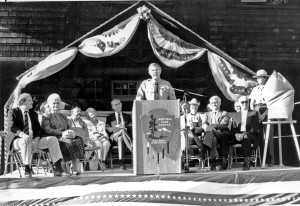
The railroad changed management and consolidated numerous times in the early year. Finally, the Atchison, Topeka & Santa Fe Railway took over and completed the track to Grand Canyon in 1901. The company could make a return on its investment through tourism because the lure of ore and mining proved to be unsustainable. The $3.95 train ride would replace the $15.00 eight-hour stagecoach ride from Flagstaff, allowing visitors to gaze upon what Teddy Roosevelt said, “Every American should see.” The 65 miles of track the iron horse traveled became the lifeline to Grand Canyon.
Grand Canyon Railway made its first journey to the Grand Canyon on September 17, 1901. And since that time, notable passengers to ride the Grand Canyon Railway include Theodore Roosevelt, John Muir, William Howard Taft, Franklin Delano Roosevelt, Dwight D. Eisenhower, Clark Gable, Jimmy Durante, Doris Day, Warren Buffet, and Bill Gates.
Over the years, the Santa Fe also built many of the structures that now grace the South Rim. After all, if they were going to start bringing people in large numbers, they had to have a way to accommodate and feed them. When the train first arrived in 1901, tent camps were found along the rim. The Santa Fe approached the development with engineering skills and technology of the times that made a wonderful contribution still evident today. In 1904, the railroad hired the Fred Harvey Company to manage the hotels and restaurants at the Grand Canyon for the Santa Fe, and in 1905, Santa Fe built its flagship hotel, the El Tovar, which became the finest lodging at the rim and arguably in the Southwest at the time.
The railroad, in a most progressive move for the times, hired Mary Elizabeth Jane Colter, a woman, to design many of the buildings that have become part of the signature of Grand Canyon National Park. Her distinctive touch stamped an indelible imprint the building at the Grand Canyon with her version of a natural style of Pueblo Indian architecture. Colter is responsible for such landmarks as the Hopi House, Lookout Studio, Bright Angel Lodge, Desert View Watchtower, and Hermit’s Rest.
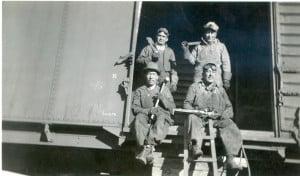
All supplies used in the construction of Grand Canyon Village came to Northern Arizona aboard the train. The train also brought all water to the Grand Canyon until 1926. Supplies were not the only things carried in trains. Ranching and lumber were the primary industries of the early 1900s. Ranchers and lumberjacks contracted with the Grand Canyon Railway to transport their stock. The Railway shared the countryside with its neighbors forming a unique bond. Cowboys, lumberjacks and shepherds alike felt a little better and closer to civilization just being able to hear the train or see its lights off in the distance.
Grand Canyon Railway stopped service to Grand Canyon in 1968 after ridership declined due to the rise in popularity of automobile travel. The Interstate highway system had been completed and people fell in love with “the road trip.” The train had been a source of regional pride, a symbol of man’s spirit of conquest and a sense of harmony with nature. Interstate highways were built paralleling the railroad, and silently replaced virgin landscapes privileged only to the train with billboards and gas stations.
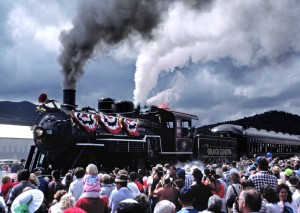
The Railway was reopened for passenger service on September 17, 1989, by entrepreneurs Max and Thelma Biegert—88 years to the day of the first passenger train to the Grand Canyon. “Bringing the Grand Canyon line back to life really came down to the eleventh hour,” explained then Williams Marshal John Moore. “As Grand Canyon Railway was working on getting the final paper-work complete, a corporation which made a failed attempt to restore the Grand Canyon line, had begun tearing it up for salvage materials. If it hadn’t been for Grand Canyon Railway, train service to the Grand Canyon would have been permanently lost.”
In 1989, Grand Canyon Railway put a stop to the salvage work and began a detailed restoration process. The decaying tracks were rebuilt, the historic depots at both ends of the line were restored, and after 21 years, passenger service once again returned to Grand Canyon National Park.
“Max Biegert and his wife Thelma brought an important piece of Arizona history back to life. We have them to thank for the opportunity to travel just as those first passengers did in 1901 to the canyon so appropriately named Grand,” said Railroad Historian Al Richmond.
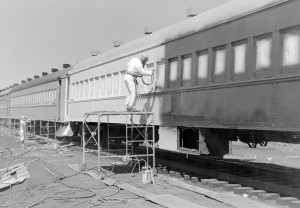
Today, Grand Canyon Railway provides a historic and fun journey to the canyon with the help of authentic western characters who bring the Old West to life. Moreover, the train whose fate seemed sealed when it was shut down due to the popularity of automobiles, is now responsible for keeping approximately 50,000 cars outside of the national treasure.
Explains Gordon Taylor, Grand Canyon Railway General Manager, “By traveling aboard Grand Canyon Railway you are not only experiencing an entertaining and historic journey, but you are also doing your part to help preserve the pristine beauty of the Grand Canyon.”
This is the precise weblog for anybody who needs to seek out out about this topic. You notice so much its almost arduous to argue with you. You positively put a brand new spin on a subject that's been written about for years. Nice stuff, simply nice!
ReplyDelete